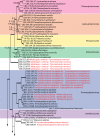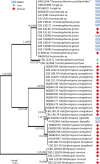Revision of agents of black-grain eumycetoma in the order Pleosporales
- PMID: 25737597
- PMCID: PMC4312930
- DOI: 10.3767/003158514X684744
Revision of agents of black-grain eumycetoma in the order Pleosporales
Abstract
Eumycetoma is a chronic fungal infection characterised by large subcutaneous masses and the presence of sinuses discharging coloured grains. The causative agents of black-grain eumycetoma mostly belong to the orders Sordariales and Pleosporales. The aim of the present study was to clarify the phylogeny and taxonomy of pleosporalean agents, viz. Madurella grisea, Medicopsis romeroi (syn.: Pyrenochaeta romeroi), Nigrograna mackinnonii (syn. Pyrenochaeta mackinnonii), Leptosphaeria senegalensis, L. tompkinsii, and Pseudochaetosphaeronema larense. A phylogenetic analysis based on five loci was performed: the Internal Transcribed Spacer (ITS), large (LSU) and small (SSU) subunit ribosomal RNA, the second largest RNA polymerase subunit (RPB2), and translation elongation factor 1-alpha (TEF1) gene. In addition, the morphological and physiological characteristics were determined. Three species were well-resolved at the family and genus level. Madurella grisea, L. senegalensis, and L. tompkinsii were found to belong to the family Trematospheriaceae and are reclassified as Trematosphaeria grisea comb. nov., Falciformispora senegalensis comb. nov., and F. tompkinsii comb. nov. Medicopsis romeroi and Pseudochaetosphaeronema larense were phylogenetically distant and both names are accepted. The genus Nigrograna is reduced to synonymy of Biatriospora and therefore N. mackinnonii is reclassified as B. mackinnonii comb. Nov. Mycetoma agents in Pleosporales were phylogenetically quite diverse despite their morphological similarity in the formation of pycnidia, except for the ascosporulating genus Falciformispora (formerly in Leptosphaeria). Most of the species diagnosed from human mycetoma were found to be related to waterborne or marine fungi, suggesting an association of the virulence factors with oligotrophism or halotolerance.
Keywords: Madurella; Pleosporales; Trematosphaeriaceae; mycetoma; taxonomy.
Figures










References
-
- Ahmed SA, Stevens DA, Sande WW van de. et al. 2014 Roussoella percutanea, a novel opportunistic pathogen causing subcutaneous mycoses. Medical Mycology 52: 689–698. - PubMed
-
- Brumpt E. 1905. Sur le mycétome à grains noirs, maladie produite par une Mucédinée dugenre Madurella n. g. Comptes Rendus des Scéances de la Société de Biologie et deses Filiales 58: 997–999.
-
- Butz WC, Ajello L. 1970 Black grain mycetoma: a case due to Madurella grisea. Archives of Dermatology 104: 197–201. - PubMed
-
- Chalmers AJ, Archibald RG. 1918 The classification of mycetomas. Journal of Tropical Medicine and Hygiene 21: 121–123.
LinkOut - more resources
Full Text Sources
Other Literature Sources
Molecular Biology Databases
Miscellaneous
